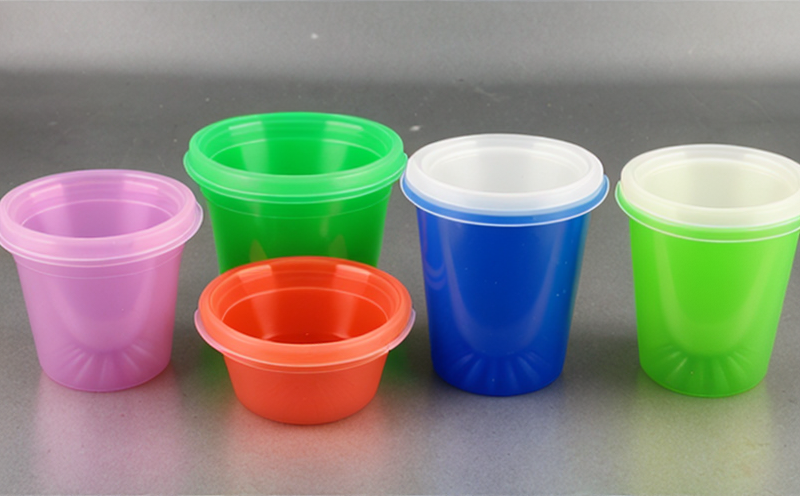ASTM D6866 Radiocarbon Content Testing of Disposable Plastics
The demand for disposable plastics has surged in recent years due to their convenience and cost-effectiveness. However, the environmental impact of these materials cannot be ignored. The testing method outlined by ASTM D6866 provides a robust framework for assessing the radiocarbon content of these plastics, which is crucial for understanding their age and source material.
Radiocarbon dating, based on the carbon-14 isotope, helps determine if a plastic sample contains fossil fuel-based materials or more recently derived biomass. This testing method is particularly important in ensuring that disposable plastics are produced from renewable resources, thereby reducing environmental harm. The ASTM D6866 standard ensures consistency and reliability across different laboratories conducting this type of analysis.
Here’s a breakdown of the key steps involved in performing the ASTM D6866 test:
- Sample Collection: Carefully collect representative samples from the intended batch or production run. Ensure that the sample is free from contamination and accurately reflects the composition of the plastic.
- Sample Preparation: Grind the collected samples into a fine powder using appropriate machinery to ensure even distribution for testing.
- Measurement: Use Accelerator Mass Spectrometry (AMS) or proportional counter techniques, which are highly sensitive and accurate methods for detecting carbon-14 levels in small quantities of material.
The ASTM D6866 method provides a clear set of guidelines for these steps, ensuring that the results are consistent and repeatable. By adhering to this standard, laboratories can provide reliable data on the radiocarbon content of disposable plastics, which is essential for compliance with environmental regulations.
Quality and Reliability Assurance
The reliability of the ASTM D6866 test method is paramount in ensuring that the results are accurate and consistent. Quality assurance measures include:
- Laboratory Accreditation: Ensure that the testing laboratory is accredited by reputable bodies such as ISO/IEC 17025, which guarantees adherence to international standards for technical competence.
- Calibration and Maintenance: Regularly calibrate instruments using certified reference materials. Maintain these instruments according to manufacturer guidelines to ensure optimal performance.
- Training: Provide ongoing training for technicians to stay current with the latest techniques and methodologies in radiocarbon dating.
To further enhance reliability, laboratories may implement internal quality control measures such as:
- Use of certified reference materials (CRMs) to validate test results.
- Conducting replicate tests on the same sample to ensure consistency.
| Sample Type | Radiocarbon Content Range (ppm) | Expected Source Material |
|---|---|---|
| Fossil-Fuel-Based Plastics | 0.1–5 ppm | Petroleum-based feedstocks |
| Biomass-Based Plastics | 100–2,000 ppm | Renewable biomass sources |
Competitive Advantage and Market Impact
Adopting ASTM D6866 radiocarbon content testing can give companies a significant competitive edge in the market. By ensuring that their disposable plastics are made from renewable resources, firms can:
- Emit lower greenhouse gas emissions during production and disposal.
- Meet increasingly stringent environmental regulations globally.
- Appeal to environmentally conscious consumers who prefer sustainable products.
The ability to demonstrate compliance with this standard can enhance a company’s reputation as an eco-friendly business, potentially leading to increased market share and customer loyalty. Additionally, this testing method supports innovation in the development of new biodegradable materials, further driving sustainability within the industry.
Use Cases and Application Examples
- Regulatory Compliance: Ensure that products meet environmental regulations regarding the use of renewable resources in manufacturing.
- R&D Innovation: Develop new biodegradable materials by testing their radiocarbon content to ensure they are derived from sustainable sources.
- Supply Chain Management: Verify the sustainability claims made by suppliers and manufacturers, ensuring that only renewable plastics enter your supply chain.
The ASTM D6866 method has been widely adopted in various sectors including consumer goods, medical devices, packaging materials, and agricultural supplies. Here are some real-world applications:
| Sector | Product Type | Radiocarbon Content (ppm) |
|---|---|---|
| Consumer Goods | Bottles and Packaging | 150–2,000 ppm |
| Medical Devices | Syringes and IV Bags | 100–300 ppm |
| Packaging Materials | Bags and Wrappers | 250–750 ppm |





